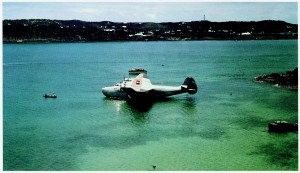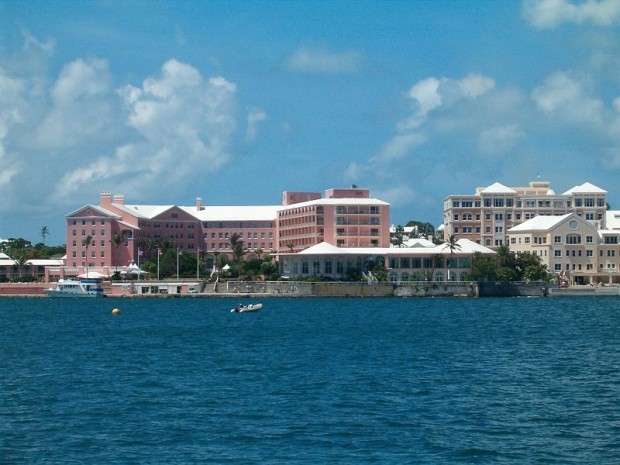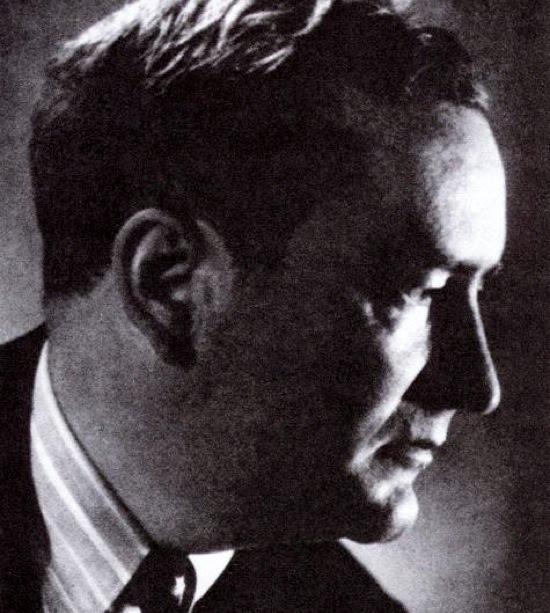Bermuda’s WWII Espionage Role
 It’s been said Bermuda was “Britain’s number-one listening post” during World War II [1939-1945] –and if that’s true, then the Princess Hotel was its headset.
It’s been said Bermuda was “Britain’s number-one listening post” during World War II [1939-1945] –and if that’s true, then the Princess Hotel was its headset.
The waterfront hotel in Hamilton was transformed into the island’s counterintelligence headquarters for the British, which monitored the transatlantic mail passing through the island aboard flying boats [a Pan American World Airways Clipper is pictured here moored off the Darrell's Island air station in the Great Sound during the war years. Bermuda was a staging point for the US-European flights operated by Pan Am and Britain's Imperial Airways].
“A thousand people worked in the basement, checking to see if letters contained messages in invisible ink or if an extra period, when magnified, might reveal a hidden message,” former hotel manager Ian Powell has said.
Ultimately some 1,500 British intelligence officers, academics and code-breakers descended on Bermuda to man the Imperial Censorship station shortly after the outbreak of the war. Many of the censors were attractive young women — largely university students — who became known as the “Censorettes”.
Though the schedule could be grueling, with thousands of letters to slog through each day, the censors found time to swim and play tennis and golf, and they even had a debate team and amateur dramatics society.
But it was hardly all sun, surf and a sybaretic lifestyle for the Bermuda censors — they were also responsible for exposing up some of the most notorious Nazi spies active in North America before the US entered World War II in 1941.
The Princess Hotel Was Headquarters To Britain’s Wartime Censorship Operation
“Bermuda proved a geographically convenient location for the scrutiny of mail exchanged between North America and Europe,” said former Tucker’s Town resident Rupert Allason, a British espionage historian who writes under the pen name Nigel West. “All correspondence sent to or from Europe was examined by Imperial Censorship staff based at the Hamilton Princess Hotel, and suspect items were intercepted and photographed.
“This led to the identification of several German spies, among them George Nicolaus and Joachim Ruge.”
But its most celebrated case involved the Bermuda censorship operations playing a key role in the uncovering of the largest Nazi espionage operation in America.
It was operated by Kurt Frederick Ludwig in 1940-41 and the network became known as the “Joe K” spy ring because it was the code name used in letters sent to Berlin addresses giving information on Allied shipping in New York Harbour and other sensitive military information. Details of the ship movements the ring provided were passed on to Nazi submarines operating in the Atlantic and a number of UK-bound vessels were torpedoed as a result.
Authorities in both the US and the United Kingdom had concluded a spy ring was operating out of New York City soon after Britain and Germany went to war in September, 1939. But the first break came when Bermuda’s censorship station — run by New York-based British Security Coordination [BSC], the organisation responsible for all UK secret intelligence activities in the Western hemisphere — intercepted letters written to “Lothar Frederick” and signed by a “Joe K”.
“The censorship examiner who had been working on thee Joe K correspondence was a very determined young lady named Nadya Gardner,” said historian H. Montgomery Hyde in an account of the Bermuda censorship station. “She thought that the letters might contain secret writing in addition to the clear text, and she sent them to the censorship laboratory for chemical tests to be applied.
“The results were negative. Nevertheless Miss Gardner was not satisfied. Fortunately she herself possessed a slight knowledge of inorganic chemistry, and she suggested that the old-fashioned iodine reagent, which was much used by the Germans during the First World War, should be tried.
“After considerable persistence by Miss Gardner in the face of the doubts voiced by the experts, this test was eventually made.
“This time the results were astonishing, since the secret writing which was brought out in every letter tested was seen to contain the latest information on aircraft production and ship ping movements.
“Morever, it was established that the secret ink was a solution of pyramidon, a powdered substance often used as a headache cure and readily obtainable at any pharmacy or drug store.”
As it was known that “Lothar” was an alias used by high-ranking Nazi official Reinhard Heydrich, a watch was set in Bermuda for any further letters with the Joe K signature.
Subsequent letters from Joe K were intercepted by the Princess Hotel censors, their contents read and recorded, and the envelopes so carefully resealed that their recipients would not detect any evidence of tampering.
Joe K had shown up as the signature on many letters sent to accommodation addresses. In March 1941 BSC chemists detected secret writing in a Joe K letter; the secret message referred to a duplicate letter sent to “Smith” in China.
The BSC mail-intercept operation was run in coordination with the US Federal Bureau of Investigation — even though its director J. Edgar Hoove and William Stephenson, the Canadian-born head of the BSC, did not get along. Knighted after the war, Sir William Stephenson later retired to Bermuda and lived here until his death in 1989.
Former Bermuda Cabinet Minister Harry Viera Featured At 00:27 Mark In Trailer For Canadian Documentary On Sir William Stephenson, “The True Intrepid”
The FBI was able to trace the Smith letter and found that it contained a plan of US defenses in Pearl Harbor, Hawaii.
Despite this break, they were still in the dark as to who were involved in the spy ring, until an unexpected event took place that led eventually to its downfall.
On the night of March 18, 1941, a middle-aged man wearing horn-rimmed spectacles and carrying a brown briefcase foolishly made the attempt to cross the street against a traffic light in New York’s Times Square.
He was hit by a taxi and fatally thrown under the wheels of another car. His companion ran into the street after him, grabbed the briefcase that fell near his body and fled from the scene.
The fatally injured man was identified as a courier for the Spanish Consulate, Don Julio Lopez Lido. His body was unclaimed for a time but the Spanish Consulate in New York finally buried him. His companion, who ran from the scene, called the dead man’s hotel and asked for them to hold the man’s room until further notice. In the meantime, the hotel management had informed the local authorities, and they began to investigate the mysterious circumstances behind the accident.
The New York Police had taken note of the seemingly uncaring action of Señor Lido’s companion as reported by witnesses, and took a deeper look into the dead courier’s background. Although he was identified as a Spaniard, they were puzzled by the fact that the dead man’s papers were in German, not Spanish; his notebook contained names and possible assignments of some US soldiers; his clothes contained no labels. Moreover a check made at the hotel room yielded maps, articles on military aviation and other curious items. All of these items were turned over to the FBI.
In the meantime, another Joe K message, also followed up by the FBI, contained a panicky message about a car in New York running down and killing a certain “Phil”. The BSC had informed the FBI that “Phil” had been Captain Ulrich von der Osten of the German Abwehr intelligence agency who had entered the United States via Japan a month prior: he was supposed to direct the activities of a group of spies in the US. Based on this, the FBI was able to determine that “Señor Lido” and von der Osten were one and the same.
Piecing together a reference from “Phil’s” notebook, an intercepted cable from Portugal to Joe K. and information from the Joe K letters intercepted in Bermuda, the FBI was able to identify von Osten’s companion as Ludwig himself. He was located and thus placed under surveillance to determine his contacts.
It was later known that von der Osten arrive in the US with the purpose of directing the Joe K spy ring; however, with his untimely death, Ludwig was left in command of the ring. Under FBI surveillance Ludwig was seen continuing his routine of visiting the docks in New York Harbor and US Army posts around the state.
Ludwig and ten other members of the Joe K spy ring were subsequently indicted in the US District Court for the Southern District of New York for treasonable conspiracy and espionage. Censors from Bermuda were flown to New York to testify against the spies.
Because their spying was undertaken before the US entered World War II, the spies escaped the death penalty and were sentenced to long prison terms instead.
Following the trial, the New York prosecuting attorney wrote to BSC headquarters at Rockefeller Centre to thank Sir William Stephenson for the role played by the Bermuda operation in breaking up the spy ring.
Wartime Portrait Of Sir William Stephenson At The Time He Headed Up British Security Coordination
“Now that the Ludwig case is finally and successfully concluded, I wish to take this opportunity of expressing to you my appreciation of the most friendly and helpful co-operation and assistance which you and your associates rendered us in that case,” said US Attorney Mathias F. Correa.
“In my opinion the testimony and exhibits furnished … by members of the Imperial Censorship stationed at Bermuda contributed very largely, in the case of some of the defendants almost wholly, to the successful outcome of the case.”
A highly successful industrialist before he was recruited by Winston Churchill to head-up British intelligence operations in the Western Hemisphere , Sir William Stephenson moved to Bermuda in the 1960s.
Ironically, he and his wife lived in a suite on the top floor of the Princess Hotel for many years before buying a home in Paget.
Although he lived a private existence here, Sir William had a small circle of close Bermudian friends and provided a number of local charities with anonymous gifts. A scholarship for local business students was established in his name at the Bermuda College.
Sir William died in Bermuda in 1989 at the age of 92 and is buried at St. John’s Church, Pembroke.
“High up on my list of heroes is one of the great secret agents of the last war …,” said James Bond author Ian Fleming, who met Sir William when he served in British Naval Intelligence during World War Two.
“People often ask me how closely the ‘hero of my thrillers, James Bond, resembles a true, live secret agent.
“To begin with, James Bond is not in fact a hero, but an efficient and not very attractive blunt instrument in the hands of government, and though he is a meld of various qualities I noted among Secret Service men and commandos in the last war, he remains, of course, a highly romanticised version of the true spy.
“The real thing, who may be sitting next to you as you read this, is another kind of beast altogether.
“… Sir William Stephenson — decorated with the Military Cross and Distinguished Flying Cross for his exploits as an aviator in World War One — became one of the great secret agents of the last war, and it would be a foolish person who would argue his credentials …
“Bill Stephenson worked himself almost to death during the war, carrying out undercover operations and often dangerous assignments …
“He was awarded the Presidential Medal for Merit, and I think he is the first non-American ever to receive this highest honour for a civilian. But it was surely [his] supreme reward that when Sir Winston Churchill recommended Bill Stephen son for a knighthood he should have minuted to King George
VI, ‘This one is dear to my heart.’
“It seems that other and far greater men than I also have their heroes.”
Read More About
Comments (5)
Trackback URL | Comments RSS Feed
Articles that link to this one:
- The largest Nazi espionage operation in North America | Jack SpyWriter King | Author of Suspense | November 12, 2011
- BIFF Event Will Leave 007 Fans Shaken, Stirred | Bernews.com | January 11, 2013
- H.G. Wells: The War Of Words In Bermuda | Bernews.com | March 17, 2013
- 1950s: Submarines ‘Snort’ From Bermuda To UK | Bernews.com | March 9, 2014




My (late) mother, a US citizen, worked for BIS (BSC) in the Rockefeller Centre,NY, abt.1940. My father, J H Martin, met Ruth while on leave in NYC (Joe was based at RAF Moose Jaw, Saskatchewan, Canada). They married late 1943 and my father was posted to Bermuda mid-1944 where I was born, Sept.1944.JHM`s position was with the RAF Met Office.
Methinks my father may have been connected to the BIS…he was a journalist by profession, from Cornwall.
David K Martin,UK.